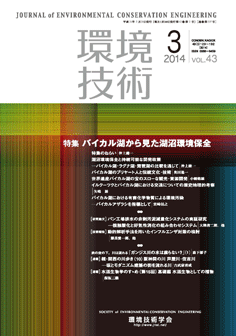All issues

Volume 43, Issue 3
Displaying 1-2 of 2 articles from this issue
- |<
- <
- 1
- >
- >|
research-articles
-
Combined Process of Contact Oxidation and Aerobic DigestionShojiro OSUMI, Katsutoshi NAKAYAMA, Akihito KUMAMI, Yoshinori KANJO2014Volume 43Issue 3 Pages 162-171
Published: March 20, 2014
Released on J-STAGE: April 01, 2014
JOURNAL FREE ACCESSSeeking to reduce the amount of excess sludge at a bread plant, we designed the following process: first, wastewater, including oil, is treated by contact oxidation; then it is separated into supernatant and floating scum by pressurized floatation. After aerobic digestion of the scum, the supernatant and the treated scum are mixed and discharged as sewage. If the mixed fluid suits for the standard for discharge into sewage, excess sludge disposal is not necessary. We tested whether the above system was workable or not. We conducted experiments on continuous contact oxidation for 230 days and continuous aerobic digestion of scum for 60 days, which resulted in a BOD removal ratio of 97% and a BOD to SS conversion ratio of 0.13 g-SS/g-removed BOD by contact oxidation, and a SS degradation ratio of 58.9% by aerobic digestion of the scum. We also showed that it is possible to express the results of the batch-wise aerobic digestion experiment with a model based on the first-order reaction supposing the existence of easily degradable, persistent, and undegradable compounds in the sludge. Finally, we calculated the material balance of the entire system and showed that the wastewater from the bread plant where we tested, including 1,200 ㎎/L of BOD and 450 ㎎/L of SS, could be treated by the process we designed with no excess sludge disposal required. This treated water includes 80 ㎎/L of BOD and 99 ㎎/L of SS and could be discharged into sewers.View full abstractDownload PDF (1212K)
Technical report
-
Aiichiro FUJINAGA, Ryo OWAKI, Masaki MOROSAWA, Shingo WATANABE, Minoru ...2014Volume 43Issue 3 Pages 172-179
Published: March 20, 2014
Released on J-STAGE: April 01, 2014
JOURNAL FREE ACCESS
- |<
- <
- 1
- >
- >|